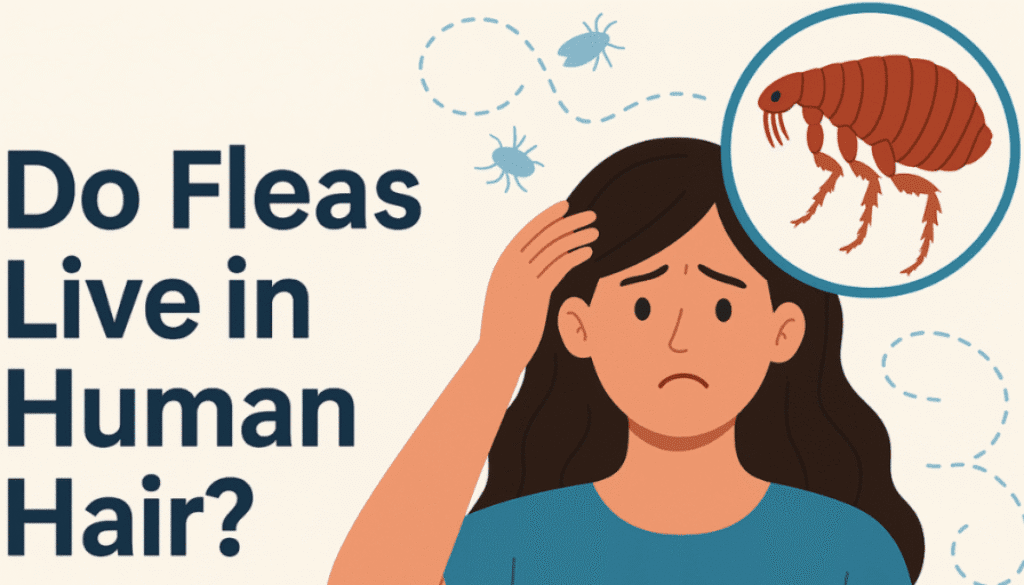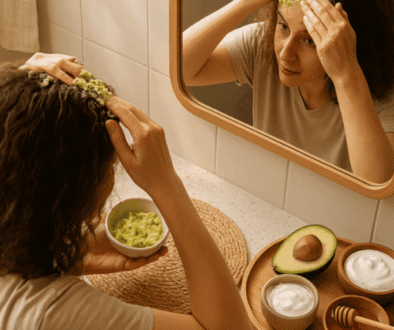Can Fleas Live in Human Hair? (2025)
“Can fleas really live in our hair?” This question causes a lot of anxiety for pet owners and parents. The idea of tiny blood-sucking pests crawling on our scalp is understandably unsettling. In reality, fleas are much more adapted to animals than people. This guide will separate myth from fact: we’ll cover what fleas are, whether they can infest human hair, how to recognize and remove them, and how to prevent flea problems in the first place.
What Are Fleas? (Simple Facts)
Fleas are small, wingless insects (about 1–4 mm long) that survive by feeding on blood. There are over 2,500 flea species worldwide; only a few commonly affect humans or pets. In the U.S., the most common are cat fleas (Ctenocephalides felis) and dog fleas (Ctenocephalides canis). There is also a human flea (Pulex irritans), but it’s rare in modern homes.
Fleas have a four-stage life cycle: eggs, larvae, pupae, and adults. Eggs are laid on a host or in its environment, hatch into larvae (worms) in a few days, then pupate into cocooned adults. Adults emerge (after about 1–2 weeks in warm conditions) and immediately seek a warm-blooded host. Fleas are expert hoppers – a cat flea, for example, can jump over 12 inches in a single bound – which is how they move quickly between pets or onto people. Like ticks and mosquitoes, fleas can transmit diseases (such as typhus or the plague) through their bites, which often cause intense itching and allergic reactions.
Flea appearance: Fleas are dark brown or black, laterally flattened (thin side-to-side), and have powerful hind legs. This body shape helps them cling to fur.
Life cycle: A female flea can lay up to 20 eggs daily (hundreds in her lifetime). Her eggs drop off into pet bedding, carpets, or soil. These eggs hatch into larvae (tiny worms that feed on organic debris) and eventually pupate in silk cocoons. Adults emerge and jump onto a passing host to feed. Importantly, fleas cannot reproduce without a blood meal.
Can Fleas Stay or Breed in Human Hair? (What Science Says)
No. Even if a flea jumps onto your scalp, it will hop off within hours or days. Without regular feeding and the right environment, an adult flea usually dies within about one week. In short, humans are not good hosts for flea breeding. Fleas simply cannot complete their life cycle on us.
According to entomologists and veterinarians, the answer is no – fleas do not live or breed in human hair. Fleas prefer furry hosts like cats, dogs, or wild animals because pet fur provides the right environment (dark, warm, humid) for shelter and continuous blood meals. Human heads, by contrast, are relatively hairless and exposed. Scientists note that humans’ mostly hairless bodies “don’t make great hiding places” for fleas.
For example, Elanco (a veterinary company) explains that fleas “seek out your dog or cat as their preferred host.” They will bite people if hungry, but “humans are difficult for fleas to attach to” and “don’t provide enough heat for them to breed or survive long term.”. In other words, on a human scalp, a flea might bite and crawl around briefly, but it won’t be able to lay eggs or multiply. Even the so-called “human flea” (Pulex irritans) rarely lives on people today.
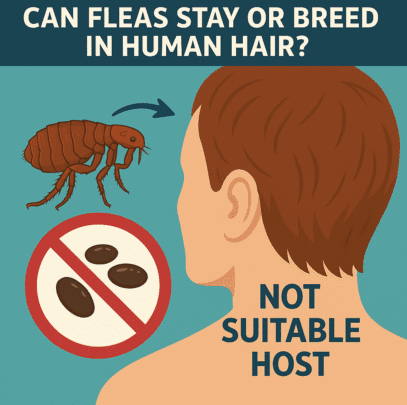
How Do Fleas Get Onto Humans?
Humans usually only encounter fleas through environmental or pet contact. The most common ways fleas can end up on you are:
From pets. The biggest risk factor is an infested dog, cat, rodent, or other animal. Adult fleas live on these animals and feed continuously. Fleas lay eggs in the animal’s fur, and those eggs fall off into carpets, bedding, or soil. If you’re near an infested pet, fleas can jump onto you by jumping from the pet’s fur or carpets and furniture. Fleas can even hop onto clothing when you’re in a flea-prone area.
Flea habitats. Fleas thrive in warm, humid environments (often summer through fall). They may hide in tall grass, leaf litter, or shady yard areas. If you walk barefoot or sit on the ground where infested animals frequent, fleas can attach and then transfer to your skin or hair. Fleas are especially active on pets, so any spot where a pet rests (car seats, couches, pet beds) can harbor fleas.
Indoor exposures. Even if you don’t have pets, fleas can hitchhike into homes on shoes, clothing, or rodents. Carpet fibers and furniture can harbor flea eggs or pupae. When these become adults, they jump onto any warm-blooded host available (including humans).
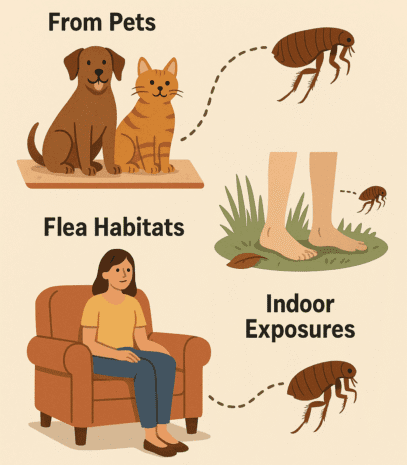
Once on a person, fleas usually don’t stay long. Elanco notes that fleas often “stay on our skin and inside our clothes in the short term, using us as a ‘carrier’ while waiting for a more suitable host.”. In practice, you might pick up a flea at home or in the yard, feel it jump on you, and then shake it off. For example, if your dog with fleas sleeps on the sofa, fleas might move into the couch fabric and occasionally onto anyone who sits there. Fleas can live under your fingernails, clothes, or in your hair for a while, but they’re generally searching for a furry animal host rather than living permanently on your body.
Signs of Fleas in Your Hair
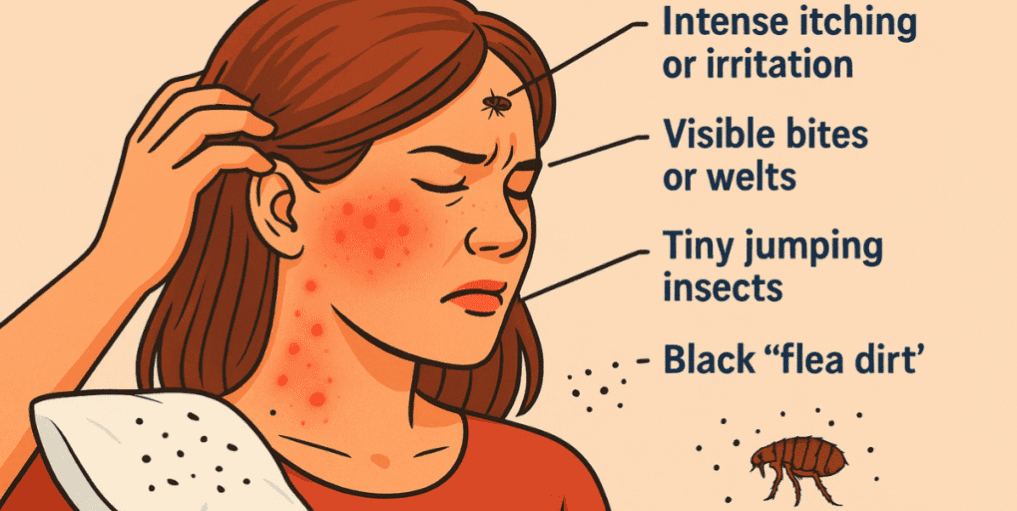
Though fleas don’t live in human hair, their bites on or near the scalp can still cause symptoms. Watch for these signs:
Intense itching or irritation. Flea bites often itch like crazy. You might feel itching along your hairline, at the base of your neck, behind your ears, or anywhere on your scalp. The irritation can be sudden and extreme, similar to lice bites because flea saliva triggers a strong histamine reaction.
Visible bites or welts. Look for small red bumps or raised welts (sometimes with a darker red center) on your scalp or neck. Flea bites often appear in clusters or lines and can swell. On the scalp, they may be small, but on your body (arms, legs) fleas usually leave multiple dots within a small area. If you notice new itchy bumps after being around pets or old bedding, fleas could be the cause.
Tiny jumping insects. You might see a small dark insect hopping quickly on your skin or in your hair. Fleas are about 1–2 mm long (barely visible) and dart quickly. Unlike lice, fleas won’t stick in your hair; they’ll hop off when you touch them.
Black “flea dirt.” Fleas excrete digested blood that looks like tiny black pepper-like specks (flea feces). Check your pillow, hair, or clothing for these black dots. If you scrape a speck onto a damp white paper towel, it may smear red (a blood residue test). Spotting flea dirt is strong evidence of fleas nearby.
All these signs together — clusters of itchy red bites and tiny dark insects or specks — point to fleas. Remember that fleas commonly bite lower body parts (feet, ankles, legs) first, so you may see bites there before noticing them on your scalp. However, if a pet sleeps on your bed or head, fleas can bite shoulders or scalp too. In any case, itching with visible jumping bugs or black specks is when you should suspect fleas rather than lint or dandruff.
What to Do If You Find Fleas in Your Hair
First, stay calm. Fleas do not multiply on your head, so you can eliminate them quickly. Follow these steps:
Remove fleas from your hair. Use a fine-tooth comb or a flea comb (like a lice comb) on wet, shampooed hair. Slowly comb from scalp to ends over a white towel or bowl of soapy water. Any fleas or eggs will get caught. You can also literally wash fleas out by vigorously shampooing and rinsing. Hot, soapy water will drown fleas. After combing, dunk the comb in soapy water to kill any trapped fleas. Repeat combing every few hours until you stop seeing fleas or eggs.
Clean combs, brushes, and bedding. Immediately wash any combs or brushes you use in hot water. Change and wash your pillows, bed linens, and any clothing or hats you recently wore in hot water (≥130°F/54°C). Vacuum carpets, rugs, and upholstery thoroughly, especially where you sleep or sit. Empty the vacuum bag outdoors promptly. The goal is to remove any flea eggs or larvae that may have fallen off your head or a pet.
Treat bites and resist scratching. Flea bites itch intensely, but scratching can break the skin and cause infection. Apply an anti-itch cream or hydrocortisone if needed. If a bite does get scratched raw, clean it with soap and water and cover it with a bandage. Cleveland Clinic advises: “Don’t scratch your flea bites… If you accidentally break your skin, keep the area clean by washing it with soap and water and covering your flea bites”. You may use over-the-counter antihistamines or aloe/honey compresses (natural remedies mentioned later) to soothe inflammation. Watch the bite sites: if redness spreads, or if you develop fever or other symptoms, see a doctor, as bite wounds can rarely become infected.
By calmly washing out the fleas and cleaning your environment, you eliminate the problem. There’s no need for panic shampoos or insecticides on your head. Over-the-counter lice treatments exist, but since fleas won’t live long on you, simple washing, combing, and cleaning are usually enough. If in doubt, though, consult a healthcare provider for advice, especially to manage itching or if the infestation is severe.
How to Remove Fleas from Hair at Home (Easy Remedies)
Besides combing and washing, some natural or DIY remedies may help complement flea removal (though evidence varies). Important: Always be cautious with home remedies, especially on children or pets, and avoid anything irritating the scalp. Here are some commonly mentioned remedies:
Fine-tooth comb: This is the most reliable “remedy.” After washing your hair, use a fine or lice comb to systematically remove fleas. Work in small sections, wiping or dunking the comb in soapy water after each pass. Repeat daily for several days to catch any newly hatched fleas.
Soapy shower or shampoo: Fleas have tiny breathing holes (spiracles) in their abdomen. A strong lather of soap (like dish soap or pet flea shampoo) can clog these and drown fleas. For example, bathing with Dawn dish soap is recommended by pet experts to remove fleas on animals; similarly, lathering human shampoo well and rinsing multiple times can flush fleas out of your hair. After shampooing, thoroughly rinse and comb again.
Anti-flea shampoos (medicated): There are no human shampoos made specifically for fleas, but over-the-counter lice shampoos (containing permethrin or pyrethrins) may kill any fleas on hair. Use caution: these products are meant for lice and should be used according to label instructions (and only if you suspect lice). They may also irritate the skin or cause resistance. For pets, there are special flea shampoos; however, do not use pet products on humans.
Natural oils and sprays: Some people use natural substances reputed to repel fleas. For example:
Coconut oil: Laboratory research has identified fatty acids from coconut oil that repel biting insects (like mosquitoes, ticks, and bedbugs) even better than DEET. While specific studies on fleas are limited, these oils may have a mild repellent effect. Applying a small amount of coconut oil to the scalp might deter fleas, but it likely won’t kill fleas that are already there.
Apple cider vinegar: This is a popular folk remedy. However, scientists say apple cider vinegar does not kill fleas. Its strong smell might repel them slightly, but any effect is due to odor rather than a biochemical action. Moreover, vinegar can irritate sensitive skin, so it’s not generally recommended. Cleveland Clinic experts advise against relying on vinegar for fleas.
Tea tree oil: This essential oil is sometimes claimed to kill or repel fleas. Tea tree oil can kill some parasites, but it must be used very carefully. Veterinary sources warn that tea tree oil is toxic if swallowed or applied undiluted. If using tea tree oil at all, dilute it heavily (a drop in carrier oil) and apply a tiny amount to clothing or a collar (not directly to the scalp). Because of safety concerns (especially for children or pets), it’s better to use proven treatments.
In summary, combing and thorough washing are the safest and most effective home methods. Natural oils and vinegar have minimal scientific support for flea removal on people, and some can cause harm if misused. If you try any home remedy, always do a patch test on the skin first and discontinue if irritation occurs.
How to Prevent Fleas in Human Hair?
Preventing fleas on yourself is largely about preventing fleas on your pets and in your environment. Key prevention strategies include:
Pet care: Since fleas prefer animals, the best protection is a regular flea prevention program for your pets. Talk to your veterinarian about year-round flea control products (oral or topical treatments) for your dog or cat. Bathe and brush your pets regularly, and check their skin for fleas (look for fleas or black specks in fur). Avoid letting pets interact with stray or wild animals that might carry fleas.
Home hygiene: Vacuum carpets, floors, and upholstered furniture frequently. Flea eggs and larvae fall off pets into carpets; vacuuming sucks them up. Immediately empty vacuum bags outdoors. Wash all bedding (both yours and your pet’s) in hot water (and dry on high heat) weekly. This kills any fleas, eggs, or larvae hidden there. For an extra measure, some people steam-clean carpets (steam kills fleas and eggs). Keeping your home clean and clutter-free also denies fleas places to hide.
Yard maintenance: Fleas thrive in shady, humid areas outdoors. Mow your lawn regularly and remove leaf litter or brush piles to expose the soil to the sun (fleas dislike direct sunlight). Keep outdoor pet areas dry (avoid overwatering) because fleas prefer moisture. If you have a dog run or kennel, treat it with outdoor pet-safe insecticides or diatomaceous earth as needed. Rake debris to disrupt flea habitats.
Limit exposure: Be cautious in places known for fleas, such as kennels, shelters, or areas frequented by feral cats/rodents. Wear long clothing outdoors, and shake out clothes and gear after being in tall grass. If possible, discourage wildlife (rats, opossums, raccoons) by sealing entry points and not leaving pet food outside.
Personal habits: Regular bathing and hair-washing don’t guarantee fleas won’t jump on you, but they help by making your scalp clean and less hospitable. Don’t share hairbrushes, hats, or scarves with those who have fleas. If someone in the house has fleas (even on their clothes or bedding), everyone should check themselves and treat their linens.
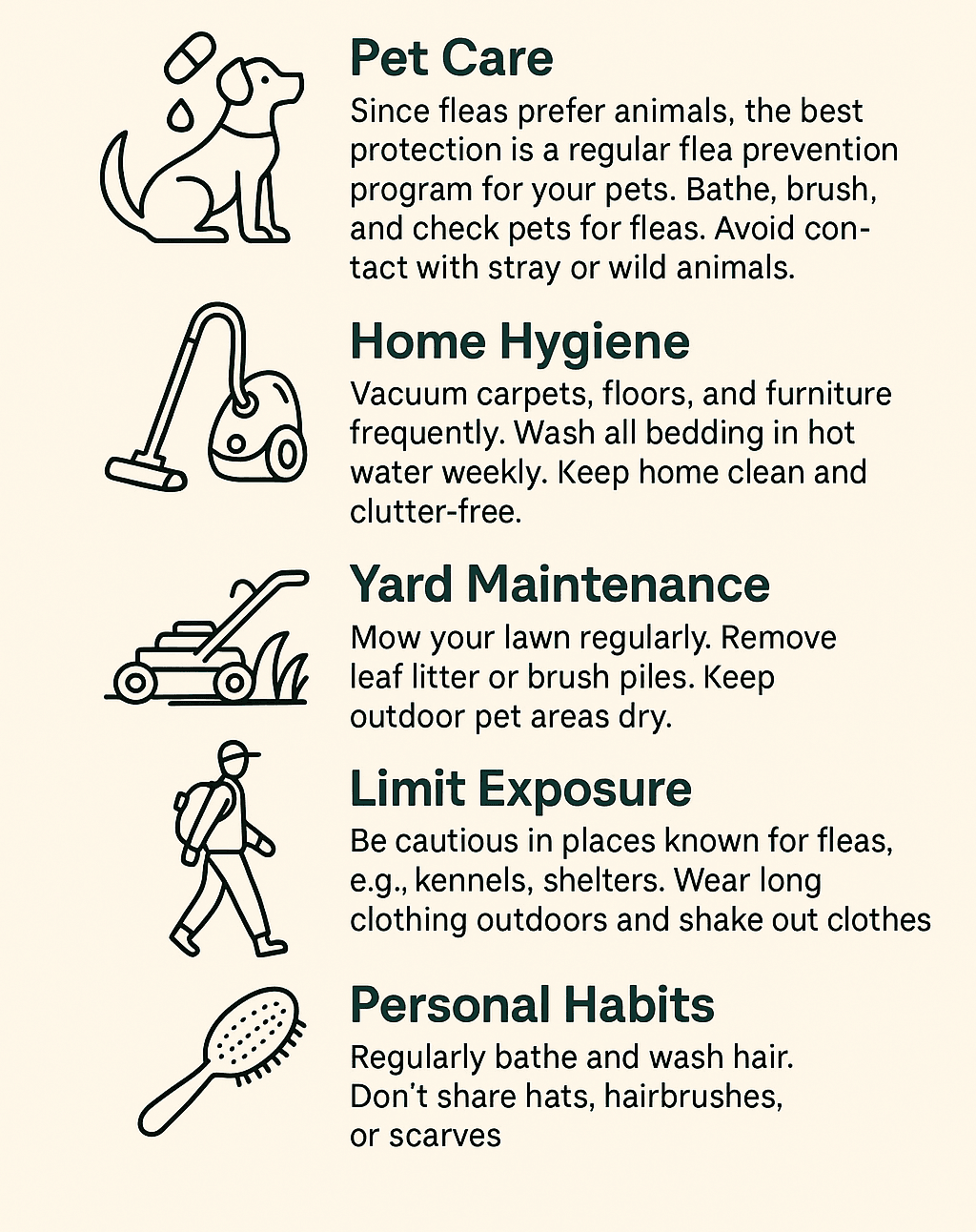
Conclusion
In summary, while fleas can bite humans, they do not live, lay eggs, or breed in human hair. The fear that “fleas got in my hair and are infesting me” is a myth. Fleas may hop onto us for a meal if we’re near pets, but they won’t establish a colony on our scalp. The most important lessons are to treat any infested pets, clean your home environment, and remove any fleas calmly. Vacuum regularly, wash bedding in hot water, use fine combing, and bathe thoroughly. Pet care is the key: keep your dog or cat on year-round flea prevention and check them often. Early action stops fleas before they become a problem.
If you ever do find fleas on yourself, remember the steps above: don’t panic, comb them out, wash everything, and soothe any bites. Flea bites can itch a lot but are normally harmless. Seek medical or pest-control help only if the situation worsens or the bites become infected. With good pet care and home hygiene, you and your family can stay safe from fleas.
Remember: Fleas prefer your pets, not your head. By caring for pets and cleaning the home, you make fleas a non-issue for humans.
